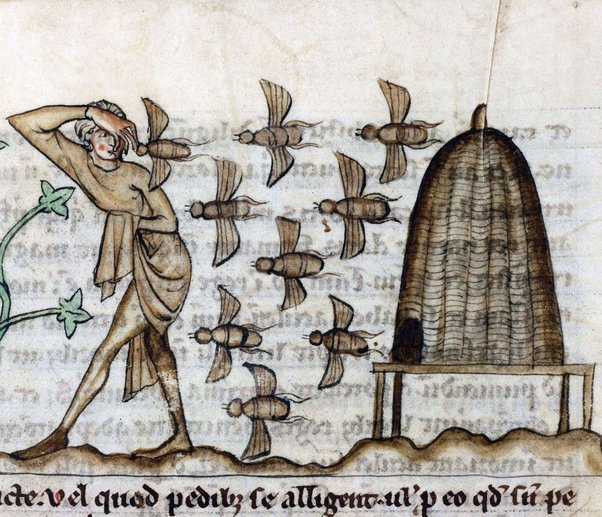In medieval Europe, a humble creature held a pivotal role in sustaining livelihoods and ecosystems: honey bees. A medieval beekeeper in the middle ages did more than just harvest sweet nectar. It was a harmonious dance between humans and nature that allowed for the delicate balance of the natural world.
Beekeeping Origins
The practice of beekeeping dates back to ancient times. Early forms of apiaries have been found in ancient Egypt, Greece, and Rome.
However, the medieval period was when beekeeping truly flourished across Europe. Monasteries in particular played a crucial role in the expansion of beekeeping knowledge. Monks tended to bee hives within their abbey gardens.
The Medieval Beehive
De Natura animalium, Cambrai ca. 1270 Douai, Bibliothèque municipale, ms. 711, fol. 37r
Medieval beehives were typically constructed by weaving straw or hollowing logs. They often resembled inverted baskets, and allowed for ventilation. The design not only protected the bees from the elements but also allowed for disrupted honey extraction.
Medieval Beekeeper Tools:
The Medieval beekeeper used a variety of tools to tend to their hives with care and precision. Smoke pots were used to calm the bees during inspections. Delicate honeycombs were crafted from wood or clay. The beekeeper’s iconic veil was also used with a mesh hood to protect against inevitable stings.
The Role of Honey Bees in Medieval Society:
Beyond honey and beeswax, bees played a many-sided role in medieval society. Honey was glorified for its medicinal properties and sweet flavor.
It was used not only as a food but also as a key ingredient in mead. Mead was the beloved fermented beverage of medieval feasts. Beeswax was used in candles, cosmetics, and even the sealing of documents.
The Spiritual Significance of Honey Bees:
Honey bees held a special significance beyond their practical utility. They symbolized industry, community, and divine providence. Bees have often been found in religious texts and artwork.
Bee hives were used as a metaphor for the ideal Christian community. Each member worked tirelessly for the greater good. All of course under the guidance of a caring ruler—the queen bee.
Beekeeping Innovations:
A medieval beekeeper was not without their challenges. Disease, pests, and adverse weather could destroy bee colonies. This would not only threaten livelihood, but also ecosystems.
Due to this, medieval beekeepers developed innovative solutions. Bee hive shelters were created. Selective breeding of resilient bee strains occurred. These early apiarists showed a strong understanding of ecological principles long before modern science.
The Legacy of Medieval Beekeepers:
Although beekeeping has evolved over the centuries, the impact of medieval beekeeping remains today. Modern apiarists are still inspired by medieval beekeepers. They recognize the wisdom and symbiotic relationship between humans and honeybees.
Perhaps there is much we can learn from the humble medieval beekeepers. They are a reminder that even the smallest creatures can have a big impact on the world around us.
Recommended content
- Interested in becoming a beekeeper? Check out this blog for the 4 best beginner beekeeping kits.
